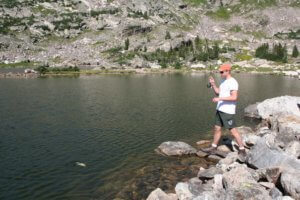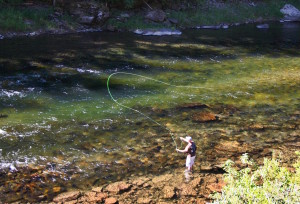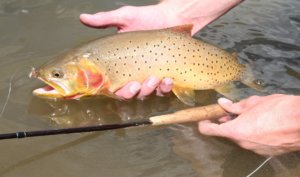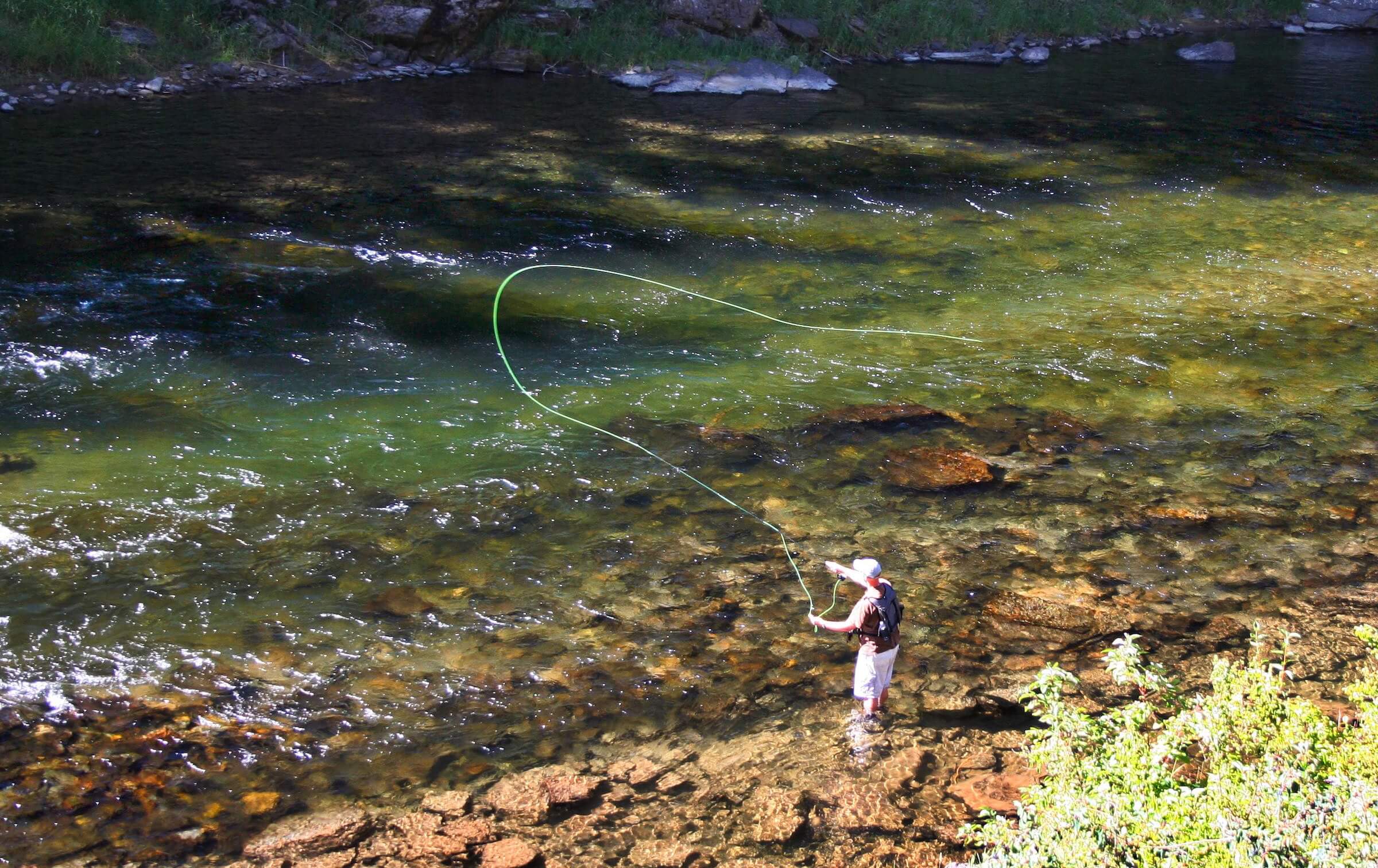
Learning to fly fish is both easier — and harder — than most people realize. On one hand, once you learn how to cast a fly rod, a fly fishing beginner can cover most of the water that’s fishable. On the other hand, learning to cast a fly rod has been known to make grown men cry.
To make learning to fly fish even more difficult, you need some specialized gear. Fortunately, you don’t need everything you see on the fully decked out fly fishermen who seem to delight in buying every tan or olive piece of gear they can find — even though you’ll eventually want some of it. No, despite all the cool fly fishing gear, a smart guy can catch trout with little more than a stick and 10 feet of fly line — just the basics.
In fact, some of the largest trout I’ve caught have been just inches from shore — hooked from a cast that was little more than a flip of my fly rod. I don’t care who you are, stalking a 20-inch trout that’s feeding within a yard from shore is an adrenaline-filled micro adventure for sure — and it doesn’t require a perfect 70-foot cast.
So how do you get started fly fishing? All you really need is some basic gear and the will to learn how to cast. And casting, it turns out, is about learning to find your rhythm.
How to Cast a Fly Rod
Obviously you need a fly rod in order to cast a fly rod, but before we talk about choosing a fly rod, let’s figure out if you think you’ve got what it takes to cast a fly rod. If this seems doable, then investing in fly fishing gear is worth it.
The trick to fly casting is all about managing two vastly different types of action — you must be both quick and firm while also having the patience to pause and wait.
For instance, to cast a fly, you must first cast your line, which then pulls the fly into place. In other types of casting, the lure is heavy and pulls the line. In fly fishing, it’s the opposite: the line is heavy and it pulls a super light lure — the fly.

If you want to fly fish, you’ve seen guys whipping their rods back and forth and unfurling beautiful soft casts. So how does this happen? By being quick and firm — then pausing and waiting — then being quick and firm again. Let me explain.
The easiest way to learn to cast is on a lawn. Get thirty feet of fly line on the ground in front of you (without a hook on the end). Hold your rod horizontal to the ground with the line going straight from the reel, through the rod, and out onto the lawn. Now you have to lift the line up into the air. To do this, you must firmly and quickly lift your rod backward and up, jerking the line off the ground. The line will then rise and shoot backward over your head and stream out behind you. At this point, you must pause. It takes time for 30 feet of line to start out in front of you and then shoot out behind you. When the line is straight out behind you — all 30 feet — hanging horizontal in the air, it’s finally time to spring into action again: You must firmly and quickly snap your rod forward and down and point it (nearly) horizontal in front of you.
That’s a core of a cast, and it’s this ability to quickly and firmly snap your line up and back . . . then have the will power to pause and wait for second or so . . . and then snap it forward with authority . . . that is the key to learning to cast a fly rod.
All along the way, you need to be firm but smooth.
Once you figure it out, fly fishing is insanely challenging but relaxing at the same time. There is no substitute for practice, and if you don’t have a buddy who can show you how in person, you should do two things: 1) watch a couple how-to videos, and 2) practice on a lawn.
Here’s one more tip: The backcast is the hardest for new fly fishermen to master. The key is to stop your fly rod in an upright position behind your head — at about the 1 or 2 o’clock position. Trouble is, most guys end up stopping around the 3 o’clock position, which causes their fly to hook the ground behind them, leading to mind-breaking frustration. Because it’s hard to visualize this going on behind your head, I recommend that newbies visualize stopping their backcast so that it’s one minute past 12 o’clock — nearly straight up. In reality, they will almost always tip farther back to the correct position.
This video is a good start:
Choosing a Fly Rod and Reel Combo
I hate to say it, but don’t buy cheap gear from a department store . . . and don’t buy used gear some anyone you don’t know. Why? Using the cheap gear will be like learning to nail together a birdhouse with a sledgehammer — you can do it, but it’s much smarter to use a hammer.

And the used gear? The risk is that the gear will be worn out or mismatched and a novice won’t know what’s wrong. For example, the fly line will likely be old and dirty, making it hard to cast. The rod might be sloppy and the reel might be misbalanced to the rod, making it difficult to learn to cast. Fly fishing is already a challenge, and trying to learn with really cheap or messed up gear is a recipe for a plate of frustration.
Does this mean you should drop a small fortune on new gear?
Definitely not. All you really need to get started fly fishing is a rod, a reel, fly line, fly backing, a leader, and a few flies — and a fishing license. That’s it. You don’t need fancypants waders. You don’t need a special vest or chest pack or boots. Sure, all this gear is fantastic, but to get started, you can keep it simple.
The best way is to choose a fly rod that comes already matched to a reel that also includes the right size of fly line. A combo is the most cost-effective and mistake-proof way to acquire a fly rod outfit. For more detail, check out, “The Best Fly Fishing Rod and Reel Combo for the Money” or “How to Choose the Best Fly Rod for Trout.” The all-around best quality rod and reel combo for anyone with a low budget is a Cabela’s Three Forks/Prestige Plus Fly Rod and Reel Combo. It’s not the best fly rod and reel combo available, but it’s an insanely good deal.
Choosing Fly Fishing Flies
Next, you need to get at least a handful of flies. Sometimes having the right fly is critical to catching smart and wary trout. Maybe you’ve heard about “matching the hatch” or situations where fish were super selective and would only choose a light green mayfly imitation and reject everything else. Don’t worry about this. Before my stepdad taught me to cast when I was a kid, he made me learn how to tie my own flies. I tied several dozen super basic flies in yellow, green, and gray. It took me weeks to get through them and most of them looked terrible. But you know what, I caught hundreds of trout on those flies . . . and they never — not once — matched any hatch. For the most part, if a fly looks like a bug, a trout will consider it.
Still, what should you choose? If you’re fishing for trout, a few patterns will cover your bases. If you have a buddy who knows what rivers or lakes you want to fish, that will help a lot. If you don’t, get a few of each of these, which will work for a lot of trout water . . . and still let you catch sunfish, bluegill, or the occasional small bass:
- size 14 Beaded Hare’s Ear nymph
- size 16 Pheasant Tail nymph
- size 14 Light Elk Hair Caddis
- size 16 Black Ant
- size 12 Hopper
- size 16 Adams
- size 16 Yellow Humpy
- size 10 Woolly Bugger
- size 12 Muddler Minnow
Of course, catching fish is an ever-changing challenge, but if I could only choose nine fly patterns for trout, I’d choose these. Later, when you’re more experienced, you’ll know more about the season, the type of water, the type of insect activity, and you’ll branch out in ways that are mind boggling now. Save those moments for later — after you’re addicted to fly fishing.
If you want to make purchasing flies easier, Cabela’s offers some excellent assortment packages of flies. The Cabela’s 84-Piece Trout Fly Assortment with Box is the most versatile pack for trout, but Cabela’s offers individual flies, as well as other categories like warm water flies for panfish and bass fishing.
Fly Line and Leader
Your first combo rod and reel will likely come with a “weight forward floating line.” Perfect. The fly line box almost always has instructions for putting it on your reel. Next, buy at least three tapered leaders. There are a lot of different types of leaders, but for now, just get a few 7.5 feet long in size 3x or 4x, which will be about 5 or 4 pound test, respectively — 3x is stronger and thicker than 4x leaders and tippet. (Confusing, I know.) And what is tippet? Tippet is the smallest, thinnest portion of a leader, but it’s also sold separately in small spools that you can cut into small sections to tie onto the thicker, butt section of a tapered leader.
So how do you tie on your fly to your leader? Just use an improved clinch knot for now. It’s easy and effective.
Clippers, Fly Floatant, Fly Boxes, and Strike Indicators
There is other handy gear you’ll need, like clippers for cutting your leader, fly floatant for making your “dry” flies float better, and fly boxes to hold and organize your flies. Plus, you might want a few strike indicators, which act like little bobbers that twitch or sink when a fish takes your fly under water. Because most feeding goes on underwater, using a strike indicator with a nymph is often the best way to catch fish.
Fly Fishing Nets, Waders, and Boots
A good fly fishing net will help you land more fish without hurting them, so a net should be high on your must-have gear list. A net is not 100 percent necessary, but it’s handy and important for catch-and-release fishing. I recommend that you make a net one of your early investments. What about waders to keep you dry? If you can afford it, get a decent pair of breathable stocking foot waders — it will help you get into cold water and get yourself into a good position for a good cast. Necessary? Depends on the river or lake and time of year you’re fishing. The same goes for wading boots. I like fishing in July, August, and September where I wade in rivers and just wear a pair of shorts. There is something fantastic about wading in cold water with the sun baking down on your back.
I usually wear wading boots, though, with a pair of neoprene booties to fill out the boot and keep my feet a bit warmer. The boots can take the abuse of the water without falling apart, plus they give me stable footing on slick, wet rocks and protect my ankles. To learn more, check out “10 Best Fly Fishing Waders for the Money.”
Learning the Water
Of course, once you have the gear and once you know how to cast, you need to learn the water where you’re going to fish. Some rivers run high and murky in May due to snow melting in the mountains that feed them. In a situation like this, you might be better off fishing a pond or lake and waiting until July for the water level to go down on the river and the water to run clear. Or you could fish a San Juan Worm pattern in May and catch hungry trout.
At the same time, you’ll need to learn to read water and figure out where fish like to hang out. There’s nothing better than a buddy to teach you this, but if you don’t have a buddy, you have three basic options: 1) keep reading about fly fishing and practicing out on the water yourself, 2) hire a guide to take you out on a river you want to learn, or 3) try to discretely watch other fly fishermen work a portion of a river or lake — essentially, you’ll be spying on them.
What you don’t want to do is get too close to another fly fishermen — give them plenty of space (like 50 yards) and respect their spot on the water. Each river or lake has different cultural norms, but when in doubt, back off if another fisherman is in a spot first.
That said, you might end up getting close to some other fishermen, in which case it’s OK to say, “Hey, how’s it going today — any luck?” And if they answer in an approachable way, you can ask something like, “Say, I’m newbie at fly fishing and I don’t know what I’m doing . . . can you recommend a fly or technique to help point me in the right direction?”
Listen to what they say then back off — let them get back to fishing — and try to follow their advice.
Fly fishing is as once a solitary pursuit while also being highly social. There’s no way to teach this other than to spend time on the water . . . and when in doubt, don’t be a jackass. Seriously. Getting along with other fly fishermen is all about respecting everyone’s space on the water.
As for learning the craft and catching fish? Well, all you have to do is catch a couple of fish . . . and then miss a lot of fish . . . and then catch a couple more fish. At this point, you’ll likely be hooked for life.
Get the Core Fly Fishing Gear:
To get started, it’s hard to go wrong with Cabela’s fly fishing gear because Cabela’s offers a great mix of quality for a reasonable price.
Entry-Level Rod and Reel Combos
- Cabela’s Three Forks Rod with Prestige Plus Reel Fly Combo
- Orvis Encounter Combo
- Redington Crosswater Outfit Fly Combo
- Cabela’s Prestige Collection Fly Outfit (easiest, one purchase option to get on the water fast)
Leaders & Tippets
Fly Fishing Flies
- Cabela’s Fly Fishing Flies (excellent quality, plenty of assortment pack options)
Strike Indicators
- Palsa Strike Indicators (easiest to install for beginners)
Fly Boxes
- Cabela’s Foam Fly Boxes (dirt simple and they work great)
Fly Floatant
Nets
- Measure Net (best net ever invented — read the review here)
Chest Packs
Waders & Wading Boots
Shop tons of fly fishing gear from Fishwest — and get free shipping on orders over $39.95!


